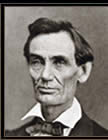An Analytical Biography of a Great Mind- by Edward J. Kempf
- PART I
- PREFACE
- INTRODUCTION
- Chapter 1 - Lincoln's Physical Constitution
- Hereditary Determination
- Hypersensitive Hypokinetic Constitution
- Meaning of Facial Asymmetries
- Fracture of Skull and Injury of Brain in Boyhood
- Diagnosis of Cerebral Lesion
- Diplopia and Eyestrain
- Borglum's Interpretation of Lincoln's Face
- Enigmatical Character of Facial Expression
- Preference for Photographs of Right Side of Face
- References
hypersensitive hypokinetic constitution
Lincoln's body growth and energic constitution show evidence of some endocrine imbalance. He was a long, thin baby at birth, with unusually long arms and legs. Lincoln grew to six feet four inches in height and generally weighed less than 180 lbs. His legs and arms were disproportionately long for his body, which when seated was about the length of an average six footer. His chest was narrow and described as flat.
The skin of his face was weather-beaten, coarse, deeply grained, dark and generally had a sallow or muddy color. Many years of close exposure in youth before an open wood fire, where he read, possibly left a permanently dystrophic effect. Deep creases over the forehead and at the outside corners of the eyes and around the mouth indicate an unusual amount of facial work in using the eyes, and in talking and laughing.
The neuromuscular tonus of his body was more relaxed than in the average man. This was shown in the slow, drawling, staccato monotone of his speech, and the deliberate, contemplative, meditative manner and slow mental reaction time, and flat feet. He seems also to have had lower blood pressure than normal, which probably, when too low, contributed to the production of nervous depression. Self-conscious of his height, he tended to slouch in posture, with stooping at the shoulders and bending slightly at the knees, but he characteristically held his chin up; indicating an ego-attitude of humility counterbalanced with well-determined self-reliance and self-respect.
Dr. K.C. Wold has also reviewed the evidence on Lincoln's physical constitution in relation to his health. He concluded that any endocrinopathy was limited to indications of some thyroid disfunction and possibly a slight postpubertal overactivity of the pituitary which might account for his disproportionately long legs and arms. Attempts to explain Lincoln's melancholic disposition on an endocrinological basis would be, he says rightly, "merely a venture in the realm of fancy."
However, even though not fully known, it would be more erroneous to disregard the indications of some degree of pituitary, thyroid and gonadal endocrinopathy, than not to consider these factors as having possibly contributed to his hypokinetic constitution. Many years of hard farm work and wood chopping from childhood to manhood, out of dire necessity for living, gave him an unusually large and powerful muscular development of hands and arms, back and shoulders. His neck, though strong, was long and scrawny looking in relation to his head and sloping shoulders. His lower jaw was long and heavy and inclined to the acromegalic form.
| Plate 2
|
His constitutional morphology was predominantly Kretschmerian (1936) asthenic, or Sheldonian (1940) ectomorphic and cerebrotonic, and his energic constitution was Kempfian (1941) hypokinetic. These qualities indicate that Lincoln was probably somewhat hyperpituitary and hypogonadal in endocrine ratio. His constitution disposed toward some reduction of autonomic pressure of energy in sexual directions and tended to produce shyness with women and a preference for the company of men, factors endlessly contributory and determinative in influence on the social conditioning and development of his personality.
His slow, drawling speech, slow reaction time and mental deliberateness, and pedestrian rhythm in style of speaking and writing were so consistent with his energic constitution and morphology that the latter, obviously, largely determined the former. In Lincoln the physiopsychological order of reactions dominated the psychophysiological. In other words, he must be and was always guided by his feelings. in what he said and did, for if they did not support him in the work of fulfilling certain self-commitments he would become miserable, if not melancholic.
next -->


